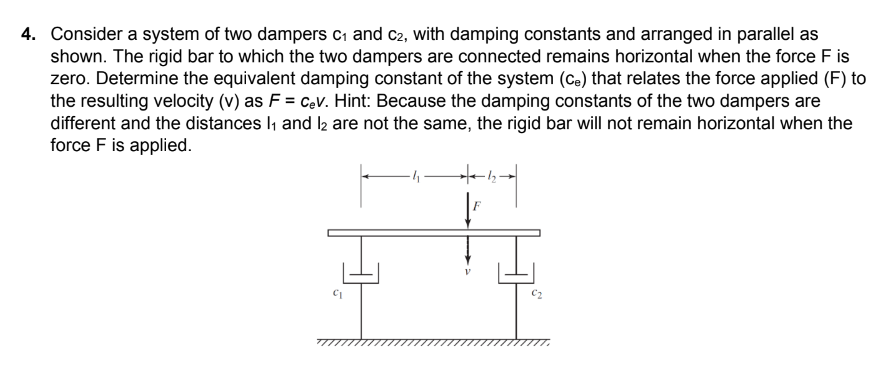Consider a system of two dampers c₁ and C2, with damping constants and arranged in parallel as shown. The rigid bar to which the two dampers are connected remains horizontal when the force F is zero. Determine the equivalent damping constant of the system (Ce) that relates the force applied (F) to the resulting velocity (v) as F = Cev. Hint: Because the damping constants of the two dampers are different and the distances 1₁ and 12 are not the same, the rigid bar will not remain horizontal when the force F is applied. # +
Consider a system of two dampers c₁ and C2, with damping constants and arranged in parallel as shown. The rigid bar to which the two dampers are connected remains horizontal when the force F is zero. Determine the equivalent damping constant of the system (Ce) that relates the force applied (F) to the resulting velocity (v) as F = Cev. Hint: Because the damping constants of the two dampers are different and the distances 1₁ and 12 are not the same, the rigid bar will not remain horizontal when the force F is applied. # +
Elements Of Electromagnetics
7th Edition
ISBN:9780190698614
Author:Sadiku, Matthew N. O.
Publisher:Sadiku, Matthew N. O.
ChapterMA: Math Assessment
Section: Chapter Questions
Problem 1.1MA
Related questions
Question
Hi, Please answer this problem, Thank you very much

Transcribed Image Text:4. Consider a system of two dampers C₁ and C2, with damping constants and arranged in parallel as
shown. The rigid bar to which the two dampers are connected remains horizontal when the force F is
zero. Determine the equivalent damping constant of the system (Ce) that relates the force applied (F) to
the resulting velocity (v) as F = Cev. Hint: Because the damping constants of the two dampers are
different and the distances 1₁ and 12 are not the same, the rigid bar will not remain horizontal when the
force F is applied.
+
Expert Solution
This question has been solved!
Explore an expertly crafted, step-by-step solution for a thorough understanding of key concepts.
This is a popular solution!
Trending now
This is a popular solution!
Step by step
Solved in 2 steps with 1 images

Knowledge Booster
Learn more about
Need a deep-dive on the concept behind this application? Look no further. Learn more about this topic, mechanical-engineering and related others by exploring similar questions and additional content below.Recommended textbooks for you

Elements Of Electromagnetics
Mechanical Engineering
ISBN:
9780190698614
Author:
Sadiku, Matthew N. O.
Publisher:
Oxford University Press

Mechanics of Materials (10th Edition)
Mechanical Engineering
ISBN:
9780134319650
Author:
Russell C. Hibbeler
Publisher:
PEARSON

Thermodynamics: An Engineering Approach
Mechanical Engineering
ISBN:
9781259822674
Author:
Yunus A. Cengel Dr., Michael A. Boles
Publisher:
McGraw-Hill Education

Elements Of Electromagnetics
Mechanical Engineering
ISBN:
9780190698614
Author:
Sadiku, Matthew N. O.
Publisher:
Oxford University Press

Mechanics of Materials (10th Edition)
Mechanical Engineering
ISBN:
9780134319650
Author:
Russell C. Hibbeler
Publisher:
PEARSON

Thermodynamics: An Engineering Approach
Mechanical Engineering
ISBN:
9781259822674
Author:
Yunus A. Cengel Dr., Michael A. Boles
Publisher:
McGraw-Hill Education

Control Systems Engineering
Mechanical Engineering
ISBN:
9781118170519
Author:
Norman S. Nise
Publisher:
WILEY

Mechanics of Materials (MindTap Course List)
Mechanical Engineering
ISBN:
9781337093347
Author:
Barry J. Goodno, James M. Gere
Publisher:
Cengage Learning

Engineering Mechanics: Statics
Mechanical Engineering
ISBN:
9781118807330
Author:
James L. Meriam, L. G. Kraige, J. N. Bolton
Publisher:
WILEY